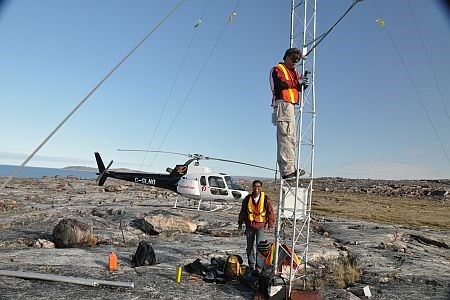From the biting, frozen winds of Baffin Island to the grit of Sudbury’s underground, Symboticware Inc. is no stranger to some of the harshest climates inflicted on Canadian mining operations.
It’s this kind of environment that led the five-year-old Sudbury company to develop the Symbot, an “intelligent monitoring” modular hardware device consisting of a small industrial computer in a rugged casing.
Interest in the product has been such that it’s currently being adapted for use in large-scale Canadian mining projects such as the two year Pando Project in Sudbury and the Baffin Island mineral initiative.
With some late summer funding from FedNor and the Ministry of Northern Development, Mines and Forestry, the company has moved into a new office on Durham Street while adding even more staff to the current crew of seven.
“All the factors, from the macro to the micro level, have been lining up for us,” says Kirk Petroski, president of Symboticware.
“We seem to be on the right path and everything’s going fairly well.”
Much of the team’s current efforts are focused in Sudbury in collaboration with the Centre for Excellence in Mining Innovation, Cast Resource Equipment, and Vale Inco.
Together they are working on the Pando Project. It is in the development phase with plans to eventually test the company’s new, more flexible Symbot system at Coleman Mine’s 153 level, mounted on a load-haul-dump (LHD) machine.
The research will result in five separate applications, including condition monitoring of such factors as hydraulic pressures and fluid temperatures.
While many loaders have these scanners in place already, the Symbot allows for wireless transmission of information in real-time. This allows for trends to be analyzed, meaning staff will be able to predict failures before they happen, says Bikash Agarwal, product manager.
By installing an inertial measurement unit onto a LHD, the Symbot will also act as a mobile weighing system. Typically, measuring the content of LHDs requires the operator to stop and lift the bucket, and the hydraulic pressure will indicate the weight of the ore.
By filtering out the “noise” of the LHD travelling over uneven and rough terrain, the inertial measurement unit will allow the system to weigh the ore on the fly. This will shave off the 30-second weigh-period required per load of ore under the current system, benefiting the production cycle as a whole, says Petroski.
The project will also include the unit as part of the ongoing Ventilation On Demand project already underway by Vale Inco at the Coleman Mine as well as Xstrata’s Nickel Rim. It will help monitor engine condition and data so the management system will know where to activate or deactivate ventilation processes.
Although the goal is to provide much of this information in real time, there are complications as underground mining often involves so-called “dead zone” areas where no wireless transmission is possible. To ensure the communication remains relatively consistent, the desired data is stored within the Symbot, and then forwarded once the unit returns to an area with wireless capability.
The flexible, modular nature of the unit means that specific uses can be swapped in, depending on demand. This was also demonstrated at the $4.6-billion Baffin Island mineral project, where advanced stage exploration is ongoing by the Toronto-based Baffinland Iron Mines Corporation.
Previously, Baffinland staff would travel to the site once a year to collect the environmental data being logged by the on-location units. With the use of Symboticware’s satellite-enabled technology, however, the information is relayed on a real-time basis.
Other advantages of this new technology use over the older style of systems used throughout the industry is the ability for Symboticware to develop artificial intelligence to handle the raw data. Rather than require client staff to have in-depth training to interpret reams of information, the artificial intelligence can drive down specifically what decision-makers need, says Lorrie Fava, manager of research and development.
These same high-level managerial types have started to pay more attention to technological developments like those at Symboticware now that the recession has led to a focus on improvement, says Petroski.
“There’s a real interest from industry right now to stop and pay attention to the innovations that are advancing right now. A year ago, this would not have happened, as you would not have got their attention because everybody was too busy with production when nickel was sitting at $20 a pound.”
www.symboticware.com




